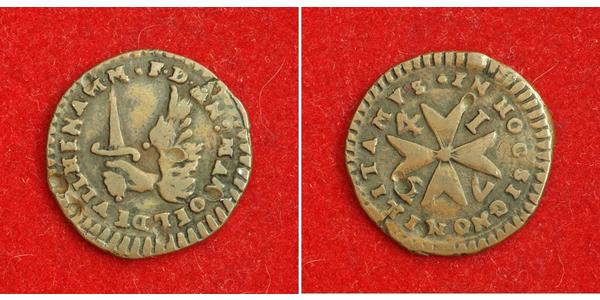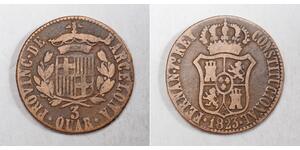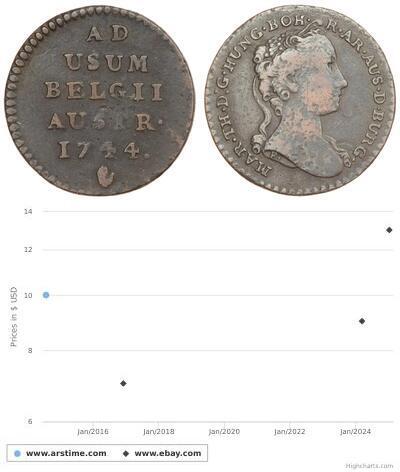(Vendue pour $89.0)
Mint Year: 1734
Mint Place: Valetta
Reference: KM-193.
Denomination: Grano
Condition: Scattered hits (circulation damage?), otherwise about XF!
Material: Copper
Diameter: 19mm
Weight: 2.44gm
Obverse: Arms of the Grand Master (winged hand, holding sword), surrounded by legend.
Legend: MANOEL DE VILHENA M M F D
Reverse: Maltese cross with date (1734) split in fields. Legend around.
Legend: IN HOC SIGNO MILITAMVS .
António Manoel de Vilhena (28 May 1663 – 10 December 1736) was a Portuguese nobleman who was the 66th Prince and Grand Master of the Order of St. John of Jerusalem from 19 June 1722 to his death in 1736. Unlike a number of the other Grand Masters, he was benevolent and popular with the Maltese people. Vilhena is mostly remembered for the founding of Floriana, the construction of Fort Manoel and the Manoel Theatre, and the renovation of the city of Mdina.
De Vilhena was elected Grand Master on 19 June 1722, three days after the death of his predecessor Marc'Antonio Zondadari. On 20 September 1722, Vilhena took possession of the city of Mdina. He was impressed by the warm welcome he received in the traditional ceremony, and on 3 November of the same year he issued orders for restoration of the city's fortifications and renovation of the entire city. The renovation was entrusted to the French architect Charles François de Mondion, who designed a number of Baroque buildings in the largely medieval city. Buildings constructed in Mdina during Vilhena's magistracy include the Mdina Gate, the Torre dello Standardo, Palazzo Vilhena, the Banca Giuratale and the Corte Capitanale.
In 1723, Vilhena financed the construction of Fort Manoel on the Isolotto (now Manoel Island after the Grand Master) in Marsamxett Harbour. The fort was completed ten years later, and it remained in use until the 20th century. Its chapel was dedicated to St. Anthony of Padua, the patron saint of the Grand Master. Vilhena also set up the Manoel Foundation in order to maintain and garrison the fort and its outworks. A bronze statue of the Grand Master was installed in the fort's piazza in 1736, and it was relocated a number of times before being placed in its present location at Pope John XXIII Square in Floriana.
Apart from the construction of Fort Manoel and the restoration of Mdina's walls, a number of improvements were made to the fortifications of Malta throughout Vilhena's magistracy. Saint Anthony's Battery was built on Gozo, the fortifications of Birgu were strengthened, and work continued on the unfinished Cottonera Lines. In 1736, the Santa Margherita Lines were finally completed nearly a century after construction had begun.
In 1724, the Grand Master founded a suburb called Borgo Vilhena in order to meet the demand for housing within the capital Valletta. The suburb was built in the area between the newly completed Floriana Lines and the Valletta Land Front. The town is now known as Floriana, and it retains symbols from Vilhena's coat of arms in its emblem.
In 1730, Vilhena built a summer residence named Palazzo Manoel (now known as Casa Leoni) in Santa Venera. He also built a hunting lodge in Naxxar in 1733, which was later converted into Palazzo Parisio. Vilhena also embellished the 16th-century Verdala Palace in Buskett.
Vilhena also ordered the construction of the Teatro Pubblico in Valletta in 1731. The theatre opened a year later, and it was renamed Manoel Theatre in the 19th century. It is still in operation today. Another public building constructed during Vilhena's magistracy is the Banca Giuratale of Gozo, which was built in 1733.
Vilhena's magistracy was marked by the only attempt to end the perpetual war between the Order and the Ottoman Empire and establish a peace treaty. Negotiations were made through the French ambassador, but nothing materialized. Vilhena maintained the Order's neutrality following the outbreak of the War of the Polish Succession in 1733.
Vilhena died on 10 December 1736 at the age of 73, and was succeeded as Grand Master by Ramon Despuig. He was buried at the Chapel of the Langue of Castile, Leon and Portugal within the Conventual Church of St. John (now known as St. John's Co-Cathedral). His funerary monument was designed by the Florentine sculptor Massimiliano Soldani Benzi.
Fort Manoel is supposedly haunted by a ghost known as the Black Knight, who resembles de Vilhena.
The Knights Hospitaller (also known as the Sovereign Military Hospitaller Order of St. John of Jerusalem of Rhodes and of Malta, Order of St. John, Knights of Malta, and Chevaliers of Malta; French: Ordre des Hospitaliers, Maltese: Ordni ta' San Gwann) was a Christian organization that began as an Amalfitan hospital founded in Jerusalem in 1080 to provide care for poor, sick or injured pilgrims to the Holy Land. After the Western Christian reconquest of Jerusalem in 1099 during the First Crusade it became a religious/military order under its own charter, and was charged with the care and defense of the Holy Land. Following the conquest of the Holy Land by Islamic forces, the Order operated from Rhodes, over which it was sovereign, and later from Malta where it administered a vassal state under the Spanish viceroy of Sicily.
The Order lost many of its European holdings following the rise of Protestantism and French Egalitarianism, but survived on Malta. The property of the English branch was confiscated in 1540. In 1577, the German Bailiwick of Brandenburg became Lutheran, but continued to pay its financial contribution to the Order until the branch was turned into a merit Order by the King of Prussia in 1812. The "Johanniter Orden" was restored as a Prussian Order of Knights Hospitaller in 1852.
The Knights of Malta had a strong presence within the Imperial Russian Navy and the pre-revolutionary French Navy. When De Poincy was appointed governor of the French colony on St. Kitts in 1639 he was a prominent Knight of St. John and dressed his retinue with the emblems of the Order. In 1651, the Knights bought from the Compagnie des Îles de l'Amérique the islands of Sainte-Christophe, Saint Martin, and Saint Barthélemy. The Order's presence in the Caribbean was eclipsed with De Poincy's death in 1660. He had also bought the island of Saint Croix as his personal estate and deeded it to the Knights of St. John. In 1665, the order sold their Caribbean possessions to the French West India Company, ending the Order's presence in that region.
The decree of the French National Assembly Abolishing the Feudal System (1789) abolished the Order in France: V. Tithes of every description, as well as the dues which have been substituted for them, under whatever denomination they are known or collected (even when compounded for), possessed by secular or regular congregations, by holders of benefices, members of corporations (including the Order of Malta and other religious and military orders), as well as those devoted to the maintenance of churches, those impropriated to lay persons and those substituted for the portion congrue, are abolished (...) (The Decree Abolishing the Feudal System, August 11, 1789, J.H. Robinson, ed., Readings in European History 2 vols. (Boston: Ginn, 1906), 2: 404-409) The French Revolutionary Government seized the assets and properties of the Order in France in 1792.
Only 1$ shipping for each additional coin purchased!























